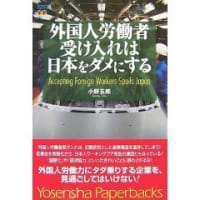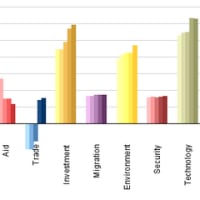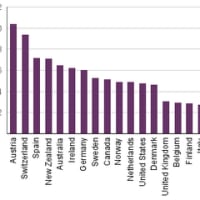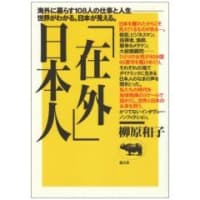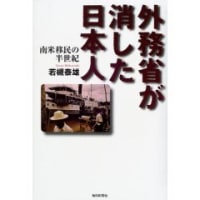あけましておめでとうございます。今年もよろしくおねがいします。
昨年12月には当ブログへの1日のアクセスが700人を超えるといううれしい知らせを受けました。これからも世界の移住労働と移民政策、そして日本型移民政策に関連する情報をタイムリーに伝えるブログサイトになるよう努めていきたいと思います。コメント・感想などいろいろとお聞かせください。
-------
今日は英エコノミストからの記事。日本の移民政策のこれからの展開について書かれたものだが、外国のジャーナリズムの描く日本の移民政策はあくまでその鎖国性に着目したものが多い。そしてこれはその典型。タイトルは和訳すれば「貧しい移民の群れを日本に押し付けるな」という感じになるだろうか…。
昨年は自民党議員連盟の草案も公にされ、日本型移民政策の議論がまったなしで始まるかと思いきや、金融危機と追い討ちをかけるような世界不況でそれもストップ。政府はまず失業した日本人の派遣社員などへの対応に追われているのが現状だ。しかし、一連の動きの中で、日系の外国人労働者への対応が指示されるなど、移住労働者が日本社会に浸透してきている証拠だともいえよう。
この厳しい環境のなかで、目先の失業問題だけに着手して、経済のファンダメンタル・競争力をつける施策をおろそかにすれば長期的にみると経済停滞の根本的な打開には結びつかない。加速する人口そして労働力の減少は日本経済を縮小させることとなるわけで、それに対応するために移民を受け入れるのか、入れないのか。入れないのであれば人口減、少子化をどう乗り切るのか?国の経済(マクロ)そして国民の生活(ミクロ)への影響は?
緊急の経済対策に加えて、将来を見据えた、日本の移民政策の形も含むような、包括的な経済そして国のありかたを示す指針が切望される。
Japanese immigration
Don't bring me your huddled masses
Dec 30th 2008 | NISHI-KOIZUMI
From The Economist print edition
Not what the conservatives want, yet some people are beginning to imagine a more mixed Japan
INFLAMMATORY remarks by Japan’s speak-from-the-hip conservative politicians—among them the prime minister for now, Taro Aso—embroil them in endless controversy with neighbours over Japan’s wartime past. In their defence, conservatives often say that what really concerns them is the future, in which they want Japan to punch its weight in the world. The question is, what weight? Japan’s population, currently 127m and falling, is set to shrink by a third over the next 50 years. The working-age population is falling at a faster rate; the huge baby-boom generation born between 1947 and 1949, the shock troops of Japan’s economic miracle, are now retiring, leaving fewer workers to support a growing proportion of elderly.
Conservatives have few answers. They call for incentives to keep women at home to breed (though poor career prospects for mothers are a big factor behind a precipitous fall in the fertility rate). Robot workers offer more hope to some: two-fifths of all the world’s industrial robots are in Japan. They have the advantage of being neither foreign nor delinquent, words which in Japan trip together off the tongue. Yet robots can do only so much.
The answer is self-evident, but conservatives rarely debate it. Their notion of a strong Japan—ie, a populous, vibrant country—is feasible only with many more immigrants than the current 2.2m, or just 1.7% of the population. (This includes 400,000 second- or third-generation Koreans who have chosen to keep Korean nationality but who are Japanese in nearly every respect.) The number of immigrants has grown by half in the past decade, but the proportion is still well below any other big rich country. Further, immigrants enter only as short-term residents; permanent residency is normally granted only after ten years of best behaviour.
Politicians and the media invoke the certainty of social instability should the number of foreigners rise. The justice ministry attributes high rates of serious crime to foreigners—though, when pressed, admits these are committed by illegal immigrants rather than legal ones. Newspaper editorials often give warning of the difficulties of assimilation.
For the first time, however, an 80-strong group of economically liberal politicians in the ruling Liberal Democratic Party (LDP), led by Hidenao Nakagawa, a former LDP secretary-general, is promoting a bold immigration policy. It calls for the number of foreigners to rise to 10m over the next half century, and for many of these immigrants to become naturalised Japanese. It wants the number of foreign students in Japan, currently 132,000, to rise to 1m. And it calls for whole families to be admitted, not just foreign workers as often at present.
The plan’s author, Hidenori Sakanaka, a former Tokyo immigration chief and now head of the Japan Immigration Policy Institute, envisages a multicultural Japan in which, he says, reverence for the imperial family is an option rather than a defining trait of Japaneseness. It’s a fine proposal, but not very likely to fly in the current political climate, especially at a time when the opposition Democratic Party of Japan is fretting about the impact of immigration on pay for Japanese workers.
Still, a declining workforce is changing once-fixed views. Small- and medium-sized companies were the first, during the late 1980s, to call for more immigrant workers as a way to remain competitive. The country recruited Brazilians and Peruvians of Japanese descent to work in the industrial clusters around Tokyo and Nagoya in Aichi prefecture that serve the country’s giant carmakers and electronics firms.
Now the Keidanren, the association of big, dyed-in-the-wool manufacturers, is shifting its position. This autumn it called for a more active immigration policy to bring in highly skilled foreign workers, whose present number the Keidanren puts at a mere 180,000.
It also called for a revamp of Japan’s three-year training programmes, a big source of foreign workers. These are supposed to involve a year’s training and then two years’ on-the-job experience. In practice, they provide cheap labour (mainly from Asia) for the garment industry, farming and fish-processing. Workers, says Tsuyoshi Hirabayashi of the justice ministry, are often abused by employers demanding long hours and paying much less than the legal minimum wage. Meanwhile, foreigners coming to the end of the scheme often leave the country to return illegally. Mr Sakanaka calls for the training programme to be abolished.
Japanese conservatives, and many others, point to the South Americans of Japanese descent as a failed experiment. Even with Japanese names, they say, the incomers still stand out. Yet in Nishi-Koizumi in Gunma prefecture, just north of Tokyo, a town dominated by a Sanyo electronics plant, the picture is different. In the family-owned factory of Kazuya Sakamoto, which for decades has supplied parts to Sanyo, three-fifths of the 300 workers are foreigners, mainly Japanese-Brazilians.
The town is certainly down at heel by comparison with the nearby capital, though it has a mildly exotic flavour in other respects, including five tattoo parlours on the main street. Yet without foreigners, says Mr Sakamoto, it is very hard to imagine there would be a town—or his family company—at all. His father was the first to recruit foreigners, and the town changed the hospitals and the local schools to suit: there are special classes in Portuguese to bring overseas children up to speed in some subjects. The result, says Mr Sakamoto, is that foreign workers send word home about the opportunities, and other good workers follow. In future, he thinks, the country should be much more welcoming to young people from around Asia.
What this new impetus for change will achieve in the near term is another matter. Not only is policymaking absent and reformism on the defensive but the global slump is hitting Japanese industry particularly hard, and foreign workers foremost. In November industrial output fell by a record 8.1% compared to the previous month, and unemployment rose to 3.9%.
A rotten time for rethinking
Mr Sakamoto says he has stopped recruiting for now, but plans no redundancies. Yet sackings of Brazilians have begun at the Toyota and Sony plants in Aichi prefecture. Some workers, says a Brazilian pastor there, have been thrown out of their flats too, with no money to return home. In Hamamatsu city, south of Tokyo, demand for foreign workers is shrinking so fast that a Brazilian school which had 180 students in 2002 closed down at the end of December; its numbers had fallen to 30. Much is made of Japan’s lifetime-employment system, but that hardly applies to foreigners.
昨年12月には当ブログへの1日のアクセスが700人を超えるといううれしい知らせを受けました。これからも世界の移住労働と移民政策、そして日本型移民政策に関連する情報をタイムリーに伝えるブログサイトになるよう努めていきたいと思います。コメント・感想などいろいろとお聞かせください。
-------
今日は英エコノミストからの記事。日本の移民政策のこれからの展開について書かれたものだが、外国のジャーナリズムの描く日本の移民政策はあくまでその鎖国性に着目したものが多い。そしてこれはその典型。タイトルは和訳すれば「貧しい移民の群れを日本に押し付けるな」という感じになるだろうか…。
昨年は自民党議員連盟の草案も公にされ、日本型移民政策の議論がまったなしで始まるかと思いきや、金融危機と追い討ちをかけるような世界不況でそれもストップ。政府はまず失業した日本人の派遣社員などへの対応に追われているのが現状だ。しかし、一連の動きの中で、日系の外国人労働者への対応が指示されるなど、移住労働者が日本社会に浸透してきている証拠だともいえよう。
この厳しい環境のなかで、目先の失業問題だけに着手して、経済のファンダメンタル・競争力をつける施策をおろそかにすれば長期的にみると経済停滞の根本的な打開には結びつかない。加速する人口そして労働力の減少は日本経済を縮小させることとなるわけで、それに対応するために移民を受け入れるのか、入れないのか。入れないのであれば人口減、少子化をどう乗り切るのか?国の経済(マクロ)そして国民の生活(ミクロ)への影響は?
緊急の経済対策に加えて、将来を見据えた、日本の移民政策の形も含むような、包括的な経済そして国のありかたを示す指針が切望される。
Japanese immigration
Don't bring me your huddled masses
Dec 30th 2008 | NISHI-KOIZUMI
From The Economist print edition
Not what the conservatives want, yet some people are beginning to imagine a more mixed Japan
INFLAMMATORY remarks by Japan’s speak-from-the-hip conservative politicians—among them the prime minister for now, Taro Aso—embroil them in endless controversy with neighbours over Japan’s wartime past. In their defence, conservatives often say that what really concerns them is the future, in which they want Japan to punch its weight in the world. The question is, what weight? Japan’s population, currently 127m and falling, is set to shrink by a third over the next 50 years. The working-age population is falling at a faster rate; the huge baby-boom generation born between 1947 and 1949, the shock troops of Japan’s economic miracle, are now retiring, leaving fewer workers to support a growing proportion of elderly.
Conservatives have few answers. They call for incentives to keep women at home to breed (though poor career prospects for mothers are a big factor behind a precipitous fall in the fertility rate). Robot workers offer more hope to some: two-fifths of all the world’s industrial robots are in Japan. They have the advantage of being neither foreign nor delinquent, words which in Japan trip together off the tongue. Yet robots can do only so much.
The answer is self-evident, but conservatives rarely debate it. Their notion of a strong Japan—ie, a populous, vibrant country—is feasible only with many more immigrants than the current 2.2m, or just 1.7% of the population. (This includes 400,000 second- or third-generation Koreans who have chosen to keep Korean nationality but who are Japanese in nearly every respect.) The number of immigrants has grown by half in the past decade, but the proportion is still well below any other big rich country. Further, immigrants enter only as short-term residents; permanent residency is normally granted only after ten years of best behaviour.
Politicians and the media invoke the certainty of social instability should the number of foreigners rise. The justice ministry attributes high rates of serious crime to foreigners—though, when pressed, admits these are committed by illegal immigrants rather than legal ones. Newspaper editorials often give warning of the difficulties of assimilation.
For the first time, however, an 80-strong group of economically liberal politicians in the ruling Liberal Democratic Party (LDP), led by Hidenao Nakagawa, a former LDP secretary-general, is promoting a bold immigration policy. It calls for the number of foreigners to rise to 10m over the next half century, and for many of these immigrants to become naturalised Japanese. It wants the number of foreign students in Japan, currently 132,000, to rise to 1m. And it calls for whole families to be admitted, not just foreign workers as often at present.
The plan’s author, Hidenori Sakanaka, a former Tokyo immigration chief and now head of the Japan Immigration Policy Institute, envisages a multicultural Japan in which, he says, reverence for the imperial family is an option rather than a defining trait of Japaneseness. It’s a fine proposal, but not very likely to fly in the current political climate, especially at a time when the opposition Democratic Party of Japan is fretting about the impact of immigration on pay for Japanese workers.
Still, a declining workforce is changing once-fixed views. Small- and medium-sized companies were the first, during the late 1980s, to call for more immigrant workers as a way to remain competitive. The country recruited Brazilians and Peruvians of Japanese descent to work in the industrial clusters around Tokyo and Nagoya in Aichi prefecture that serve the country’s giant carmakers and electronics firms.
Now the Keidanren, the association of big, dyed-in-the-wool manufacturers, is shifting its position. This autumn it called for a more active immigration policy to bring in highly skilled foreign workers, whose present number the Keidanren puts at a mere 180,000.
It also called for a revamp of Japan’s three-year training programmes, a big source of foreign workers. These are supposed to involve a year’s training and then two years’ on-the-job experience. In practice, they provide cheap labour (mainly from Asia) for the garment industry, farming and fish-processing. Workers, says Tsuyoshi Hirabayashi of the justice ministry, are often abused by employers demanding long hours and paying much less than the legal minimum wage. Meanwhile, foreigners coming to the end of the scheme often leave the country to return illegally. Mr Sakanaka calls for the training programme to be abolished.
Japanese conservatives, and many others, point to the South Americans of Japanese descent as a failed experiment. Even with Japanese names, they say, the incomers still stand out. Yet in Nishi-Koizumi in Gunma prefecture, just north of Tokyo, a town dominated by a Sanyo electronics plant, the picture is different. In the family-owned factory of Kazuya Sakamoto, which for decades has supplied parts to Sanyo, three-fifths of the 300 workers are foreigners, mainly Japanese-Brazilians.
The town is certainly down at heel by comparison with the nearby capital, though it has a mildly exotic flavour in other respects, including five tattoo parlours on the main street. Yet without foreigners, says Mr Sakamoto, it is very hard to imagine there would be a town—or his family company—at all. His father was the first to recruit foreigners, and the town changed the hospitals and the local schools to suit: there are special classes in Portuguese to bring overseas children up to speed in some subjects. The result, says Mr Sakamoto, is that foreign workers send word home about the opportunities, and other good workers follow. In future, he thinks, the country should be much more welcoming to young people from around Asia.
What this new impetus for change will achieve in the near term is another matter. Not only is policymaking absent and reformism on the defensive but the global slump is hitting Japanese industry particularly hard, and foreign workers foremost. In November industrial output fell by a record 8.1% compared to the previous month, and unemployment rose to 3.9%.
A rotten time for rethinking
Mr Sakamoto says he has stopped recruiting for now, but plans no redundancies. Yet sackings of Brazilians have begun at the Toyota and Sony plants in Aichi prefecture. Some workers, says a Brazilian pastor there, have been thrown out of their flats too, with no money to return home. In Hamamatsu city, south of Tokyo, demand for foreign workers is shrinking so fast that a Brazilian school which had 180 students in 2002 closed down at the end of December; its numbers had fallen to 30. Much is made of Japan’s lifetime-employment system, but that hardly applies to foreigners.











